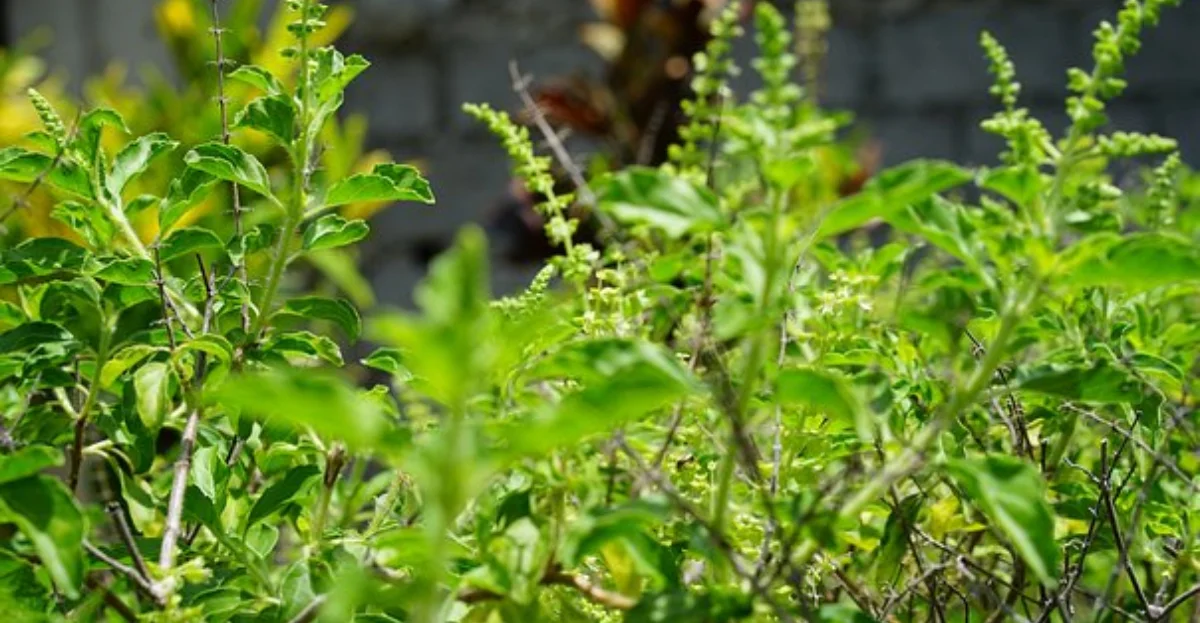Table of Content
- Auspicious Directions for Tulsi Plant as per Vastu
- Ideal Spots to Place Tulsi at Home
- Areas to Avoid for Tulsi Placement
- Key Vastu Tips for Tulsi Placement
- Directions to Avoid
- Can Tulsi Be Kept Near the Main Entrance?
- Why Tulsi Should Not Be Placed on Rooftops
- Benefits of Tulsi Plant as per Vastu
- Spiritual and Mythological Importance of Tulsi
- Different Varieties of Tulsi for Homes
- How to Worship Tulsi at Home
- How Many Tulsi Plants Should You Keep?
- Vastu Rules for Plucking Tulsi Leaves
- Conclusion
Sometimes, peace, spiritual energy, and positive vibes begin with a pot, a sacred plant, and the right direction.
That’s exactly why the Tulsi plant holds a special place in Indian homes. More than just greenery, Tulsi revered as an incarnation of Goddess Lakshmi brings purity, protection, and spiritual harmony. But here’s the key: its true benefits are unlocked only when placed according to tulsi plant vastu shastra principles.
When I first brought Tulsi home, I didn’t think much about placement. Over time, I learned that the direction, location, and care make all the difference in inviting health, prosperity, and positivity.
In this guide, I’ll share everything I’ve discovered about Tulsi plant placement the ideal directions, essential care tips, and Vastu dos and don’ts that can truly transform your home’s energy.
Auspicious Directions for Tulsi Plant as per Vastu
The placement of Tulsi can directly influence your family’s health, peace, and prosperity. Here are the most favorable directions according to tulsi plant vastu shastra:
East Facing
East is the direction of the rising sun and symbolizes fresh beginnings. Governed by Lord Indra, placing Tulsi here brings vitality, optimism, and spiritual energy. I have found that an east-facing Tulsi gets just the right amount of morning sunlight, which helps it flourish.
Northeast (Ishan Kon)
The northeast corner is considered the most sacred direction in Vastu. Known to attract divine and positive energies, placing Tulsi here is believed to enhance well-being, prosperity, and harmony. My Tulsi plant in the northeast corner has brought a noticeable calmness and positivity to my home.
North Direction
Ruled by Lord Kubera the deity of wealth the north direction is also auspicious. Placing Tulsi here helps in attracting prosperity and maintaining a peaceful household. Families I know have observed financial stability and peace after following this placement.
Also Read: Money Plant Vastu Tips: Best Directions, Do’s & Don’ts for Positive Energy
Ideal Spots to Place Tulsi at Home
In addition to direction, location matters:
- Brahmasthan (Center of the House): Radiates energy to the entire home.
- Pooja or Prayer Room: Strengthens spiritual connections.
- Balcony or Open Area: Provides natural sunlight and airflow.
- East/North-Facing Window: Great option for apartments and small spaces.
Personally, I keep mine near an east-facing balcony window. It’s not only practical but also fills my mornings with fresh, positive energy.
Areas to Avoid for Tulsi Placement
Certain locations should be strictly avoided to prevent energy imbalances:
- Directly on the Ground: Always use a raised platform or pot for sanctity.
- Near Bathrooms or Damp Corners: Negative energy and humidity can harm the plant.
- Kitchen (Southeast): The fire element conflicts with Tulsi’s calming energy.
- Bedroom: Usually lacks sunlight and ventilation, leading to stagnant energy.
Key Vastu Tips for Tulsi Placement
For maximum benefits, I follow these simple rules:
- Ensure your Tulsi gets plenty of sunlight and fresh air.
- Keep the area clean, clutter-free, and sacred.
- Avoid placing thorny plants or dustbins nearby.
- Pair with flowering plants for enhanced energy.
- Never leave a dried or unhealthy Tulsi plant it disrupts positive vibrations.
Directions to Avoid
According to tulsi plant vastu shastra, avoid placing Tulsi in the south, southeast, southwest, west, or northwest. These directions are linked with disharmony, financial stress, and even relationship issues.
Can Tulsi Be Kept Near the Main Entrance?
Yes! Placing Tulsi in an open space near the main door, especially in the north, northeast, east, or central area, is highly beneficial. It acts as a natural barrier against negative energies and allows positive vibrations to enter your home.
Why Tulsi Should Not Be Placed on Rooftops
While some people keep Tulsi on rooftops due to space constraints, Vastu experts generally discourage this. Rooftop placement may lead to financial instability or create disharmony. A balcony or window ledge in the right direction is a better choice.
Benefits of Tulsi Plant as per Vastu
Keeping Tulsi at home offers several benefits:
- Medicinal Value: Acts as a natural immunity booster; Tulsi tea has helped my family stay healthy during seasonal changes.
- Peaceful Ambience: Reduces stress and radiates positivity.
- Air Purification: Absorbs toxins and repels mosquitoes naturally.
- Balances Pancha Bhootas: Harmonizes earth, water, fire, air, and space elements.
- Promotes Marital Harmony: Enhances love, peace, and prosperity among family members.
Spiritual and Mythological Importance of Tulsi
Tulsi plays a vital role in religious rituals:
- Leaves are used in Panchamrit, garlands, and pooja offerings.
- Tulsi Vivah: Symbolic wedding of Tulsi with Lord Vishnu before the Hindu wedding season.
- Ancient texts like the Tulabharam story of Lord Krishna highlight its unmatched spiritual power.
Worshipping Tulsi daily, following tulsi plant vastu shastra, has strengthened my spiritual practices immensely.
Different Varieties of Tulsi for Homes
- Rama Tulsi (Green): Mild flavor, ideal for daily rituals and medicinal use.
- Shyama/Krishna Tulsi (Purple): Potent in treating respiratory issues and infections.
- Kapoor Tulsi: Aromatic, acts as a natural mosquito repellent.
- Vana Tulsi: Wild variant with high medicinal value.
I personally grow Rama Tulsi for daily prayers and Krishna Tulsi for its therapeutic benefits.
Also Read: Where to Place an Overhead Water Tank as per Vastu?
How to Worship Tulsi at Home
- Build a small Tulsi Chaura (altar) in the northeast or an open balcony.
- Keep the space tidy and uncluttered.
- Light a ghee or oil lamp daily and offer water, kumkum, and flowers.
- Circumambulate while chanting sacred mantras.
- Prefer stone, granite, or marble pots; avoid plastic containers
Regular worship brings immense peace and prosperity I’ve experienced this firsthand.
How Many Tulsi Plants Should You Keep?
Odd numbers (1, 3, or 5) are considered auspicious in tulsi plant vastu shastra, as they maintain energy balance and amplify benefits.
Vastu Rules for Plucking Tulsi Leaves
- Don’t pluck after sunset or on Sundays, Amavasya, Dwadashi, or Chaturdashi.
- Always use fingers instead of nails and wash your hands before plucking.
These rituals honor Tulsi’s sacredness and preserve its divine energy.
Conclusion
In my experience, following tulsi plant vastu shastra principles ensures a home filled with health, prosperity, and positivity. Tulsi is more than a plant it’s a source of spiritual energy, medicinal benefits, and emotional well-being. Proper placement, regular care, and mindful worship amplify its impact. I’ve noticed a tangible difference in the atmosphere of my home since incorporating these Vastu guidelines, and I highly recommend anyone looking to harmonize their living space to do the same.










Ans 1. Tulsi is revered as a sacred plant associated with spiritual energy, health, and prosperity. It is believed to purify the home, protect against negative energies, and bring peace and harmony to residents.
Ans 2. The most auspicious directions are east, northeast (Ishan Kon), and north. East-facing placement brings vitality, northeast attracts divine energy, and north helps attract prosperity and financial stability.
Ans 3. Tulsi can be placed in a pooja or prayer room, on a balcony or near an east/north-facing window, or in the Brahmasthan (center of the house). These spots provide sunlight, ventilation, and positive energy flow.
Ans 4. Yes. Avoid placing Tulsi in the south, southeast, southwest, west, or northwest. It should not be kept in bedrooms, kitchens, bathrooms, damp areas, or directly on the ground, as these locations may cause energy imbalance.
Ans 5. Yes. Tulsi near the main entrance, especially in the north, northeast, or east, acts as a natural barrier to negative energy while allowing positive vibrations to enter your home.
Ans 6. Rooftop placement can lead to financial instability or disharmony according to Vastu. A balcony, terrace edge, or window ledge with proper sunlight is preferred.
Ans 7. Tulsi offers medicinal value, purifies the air, reduces stress, balances natural elements (Pancha Bhootas), promotes marital harmony, and enhances spiritual energy in the home.
Ans 8. Rama Tulsi is ideal for daily rituals and medicinal use, Krishna/Shyama Tulsi for respiratory and therapeutic benefits, Kapoor Tulsi as a mosquito repellent, and Vana Tulsi for medicinal potency.
Ans 9. Create a small Tulsi altar, keep it clean, offer water, flowers, and light a ghee/oil lamp daily. Circumambulate the plant while chanting mantras. Stone, granite, or marble pots are preferred over plastic.
Ans 10. Odd numbers (1, 3, or 5) are considered auspicious. Leaves should not be plucked after sunset or on Sundays, Amavasya, Dwadashi, or Chaturdashi. Use fingers instead of nails and wash hands before plucking to maintain sacred energy.